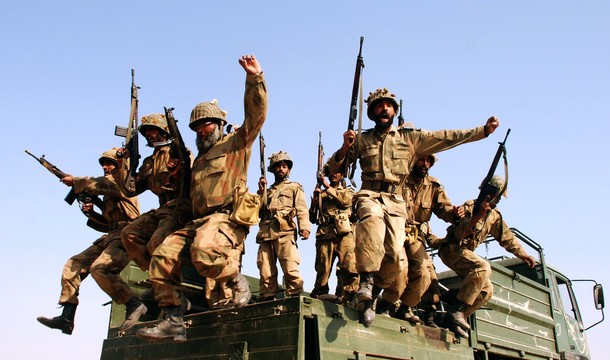
The Obama administration coined a new phrase upon taking office, "AfPak," to refer to the importance of tackling Afghanistan and Pakistan’s problems in a coherent way. With the firing of General Stanley McChrystal, it’s clear the White House is reformulating its policy toward the Karzai government in Kabul. But what has happened to Pakistan policy?
Washington and Islamabad appear to have different objectives while speaking about common goals: While both are fighting terrorism and militancy, the United States is looking for a safe military exit out of a stabilized Afghanistan while ensuring that al Qaeda does not re-emerge. Pakistan seeks to secure its own territory against an active homegrown insurgency, while keeping a wary eye on India to its east.
Last year, other observers and I raised an alarm about the urgent need to stabilize the Pakistan economy and better equip its military to withstand the rise of militancy and insurgency inside this key non-NATO ally. A nuclear-armed Pakistan, occupying a key strategic location near India, Iran, the Arabian Peninsula, Afghanistan and Central Asia, risked being isolated and mired in economic difficulties—and unable to afford to mount the war on terror within its own borders.
The U.S. responded with some far reaching measures: a long-term aid package in the form of the Kerry-Lugar-Berman Bill; the appointment of Ambassador Richard Holbrooke as Special Representative for Afghanistan and Pakistan; and the opening of a high-level dialogue with civil and military authorities in Pakistan. For its part, Pakistan’s fledgling democracy turned back some of the egregious constitutional restraints of the autocratic regime of President Pervez Musharraf; re-ordered the relations between the federal government and the provinces; and prepared to impose a nationwide value-added tax to buy itself some fiscal space.
But my latest analysis for the Atlantic Council, "Pakistan in the Danger Zone," notes that too much has been left undone and the speed of actions inside Pakistan and from abroad is too slow.
Start with aid. The 24-nation Friends of Democratic Pakistan promised $5.6 billion in April 2009 and has to date delivered just $725 million. The amount of U.S. aid has been woefully inadequate to the job at hand: no more than $2 billion a year compared with $30 billion spent in Afghanistan. Military equipment for the army to fight insurgents is still sparse and slow in coming. Pakistan needs helicopters, jamming devices, and engineering equipment to build roads and bridges in the borderlands, as well as better personal protection for its troops.
Then there’s trade. The U.S. market remains closed to Pakistan’s most globally competitive industry, textiles. A "trade not aid" model might win Pakistani hearts and minds, and cost the U.S. taxpayer less to boot. But the Obama administration has not shown any political will to extend the same kind of tariff cuts to Pakistan that it has extended to other trading partners.
At home in Pakistan, the government of Asif Ali Zardari has had its own problems consolidating its power and getting the economy back on track. The finance ministry has been a revolving door. Pakistan needs to grow at 7% to 8% to keep ahead of population growth, not its current target of 3%. Public spending has huge leakages and taxes are burdensome. But without aid to tide the government over and trade to jumpstart more sustainable growth, the country’s immediate economic prospects are dim.
Without a stronger economy, Pakistan will have a difficult, if not impossible time combating the insurgency within its own borders—an insurgency that threatens to spill over into Afghanistan.
The U.S. can help. First the Obama administration can follow through on its promises and rapidly deploy promised development and military aid. With Washington’s urging, other donors can be spurred into action, too. Second, the U.S. can lead an effort to free trade with Pakistan, especially in key sectors like textiles and apparel. Third, the U.S. could open a dialogue on a civil-nuclear deal as a symbol that it wants to bring Islamabad into the fold of responsible nations. Fourth, Washington can help launch infrastructure projects to knit the country together and provide much-needed jobs. Lastly, the two nations could establish education centers to upgrade human capital and strengthen civil society.
For its part, Pakistan must take ownership of the aid program by preparing sound project plans with performance indicators built into them. The government must rid itself of corruption and cronyism and establish institutions to better manage development and to build on recent reforms. And it could offer an olive branch to its neighbor, India, and offer to liberalize trade. The current bilateral trade of $2 billion between the neighbors could rise to more than $50 billion if the borders were opened and nontariff barriers removed. This would lift incomes on both sides of the border.
It’s not too late for the U.S. to retool its Pakistan strategy, but time is running out. The people of Pakistan need jobs just as much as they need security. Without economic prosperity, neither is possible. That’s a scary prospect for a country that’s a key ally in the war on terror—an ally that cannot, and should not, be ignored by the White House.
Shuja Nawaz is director of the Atlantic Council’s South Asia Center in Washington and the author of "Crossed Swords: Pakistan, Its Army, and the Wars Within" (Oxford 2008). This article is adopted from "Pakistan in the Danger Zone: the Tenuous U.S.-Pakistan Relationship" (Atlantic Council, 2010).
This artictle was originally posted on the Wall Street Journal web site.